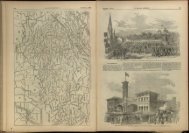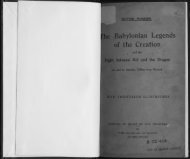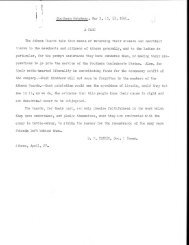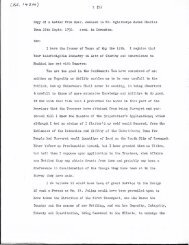THE SHE KING; OR, THE BOOK OF ANCIENT POETRY
THE SHE KING; OR, THE BOOK OF ANCIENT POETRY
THE SHE KING; OR, THE BOOK OF ANCIENT POETRY
You also want an ePaper? Increase the reach of your titles
YUMPU automatically turns print PDFs into web optimized ePapers that Google loves.
N I<br />
32<br />
<strong>THE</strong> RHYME AND METRE <strong>OF</strong> <strong>THE</strong> PIECES.<br />
frequently quatrains; but the authors allowed themselves<br />
as much liberty in the length of the stanza as in that of<br />
the line. Stanzas of two lines are very rare ; and those<br />
of three lines, or triplets, are only less so. One ode<br />
occurs, made up of stanzas of two lines, and in another<br />
three such stanzas follow three quatrains. We have three<br />
odes made up of triplets, and this stanza is occasionally<br />
introduced among others of greater length. Stanzas of<br />
five lines occur, but not often. They sometimes form the<br />
structure of whole pieces, and are sometimes intermixed<br />
with others. Stanzas of six lines, of eight, of ten, and of<br />
twelve are frequently met with. Some are found extend<br />
ing to fourteen lines, and even to sixteen and seventeen.<br />
Those of seven lines, of nine, and of eleven, are all un<br />
usual. Generally speaking, stanzas with an even num<br />
ber of lines greatly outnumber those with an odd.<br />
In the present metrical version, wherever I could con<br />
veniently attain to it, I have made the stanzas of the<br />
same length as in the original Chinese. Some expansion,<br />
however, has frequently seemed to be necessary; con<br />
densation has seldom been possible.<br />
3. The manner in which the rhymes are disposed has<br />
Disposition of received much attention from the Chinese<br />
tiie Rhymes, critics; and the following cases, among<br />
others, have been pointed out:—<br />
[i.] Where lines rhyme in succession; two, three, four<br />
lines, &c., occasionally up to twelve.<br />
[ii.] Where the rhyming lines are interrupted by one ov<br />
more lines intervening, which do not rhyme with them ;<br />
those intervening lines rhyming differently together, or<br />
not rhyming at all.<br />
[iii.] Where the stanza contains only one rhyme.<br />
[iv.J Where the stanza contains two or more rhymes,<br />
[v.] AVhere the different rhymes alternate, with more<br />
or less of regularity. Some pieces are made up of<br />
quatrains proper, the first and third lines rhyming to<br />
gether, and the second and fourth. In. stauzas of five<br />
lines, the first and third will sometimes rhyme, and then<br />
the second, fourth, and fifth. In others of six lines, the<br />
first and third will rhyme, and then the second, fourth,<br />
fifth, and sixth. The regularities, or rather irregularities,<br />
of this kind are very numerous.<br />
<strong>THE</strong> RHYME AND METEE <strong>OF</strong> <strong>THE</strong> PIECES. 33<br />
[vi.] Where one or more lines at the commencement<br />
of the different stanzas of a piece, or their concluding<br />
lines, rhyme with one another. In all the instances<br />
adduced to illustrate this case, however, we have not<br />
merely a concord of the rhymes, but the repetition of the<br />
whole lines.<br />
[vii.] What we call medial rhymes occur occasionally;<br />
and in a few instances the members of different lines<br />
rhyme in this way at the csesural pause.<br />
Without specifying other characteristics, I may say<br />
that there are throughout the pieces multitudes of lines,<br />
sometimes one, and sometimes more, which do not rhyme<br />
with any others in the same stanza. The pieces of Part<br />
IV. have several peculiarities. Many of them do not<br />
admit of a stanzaic arrangement; and there are at least<br />
eight in which there is no attempt at rhyme. We may<br />
consider such disregard of rhyme as an approach to the<br />
structure of blank verse; but while every other irregu<br />
larity in the ancient odes has found imitators, I am not<br />
aware that this has received any favour. So far from the<br />
Chinese having any contempt for rhyming, such as<br />
Milton expressed when he called it "a jingling sound of<br />
like endings," " a troublesome bondage," they consider<br />
it essential to poetry.<br />
In the present version, as in the prose one of my larger<br />
work, I have made no attempt to adhere to the length of<br />
the original lines, or to adopt their rhymes. The dif<br />
ferent attributes of the Chinese and English languages<br />
made it impossible to do so. In passing from this sub<br />
ject, I will venture to say that the nature of Chinese is<br />
at the best but ill adapted for the purpose of agreeable<br />
rhyme. It does not admit the variety that is found in an<br />
alphabetical language, and which is to us one of the<br />
charms of poetical composition. The single rhyming<br />
endings in English are about 360; and if we add to them<br />
the double and triple rhymes, where the accent falls on<br />
the penultimate syllables, they cannot come short of 400.<br />
In Chinese, on the other hand, the rhyming endings are<br />
very few. Those of the Book of Poetry are under twenty.<br />
There is, indeed, in Chinese a greater number of words<br />
or characters to any one ending than in other languages,<br />
and scholars have produced compositions in which the<br />
vor,. m. 3








